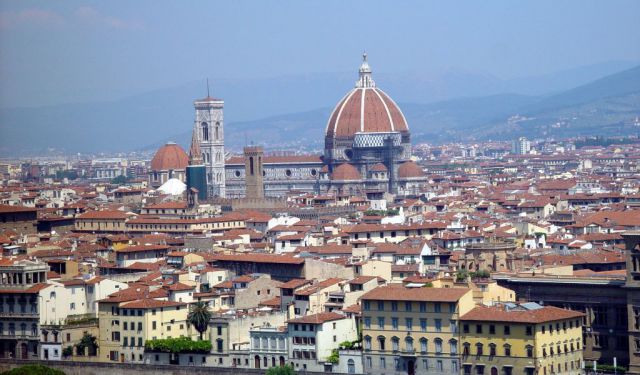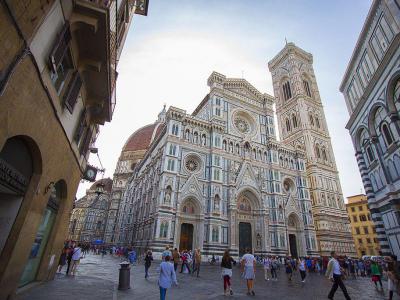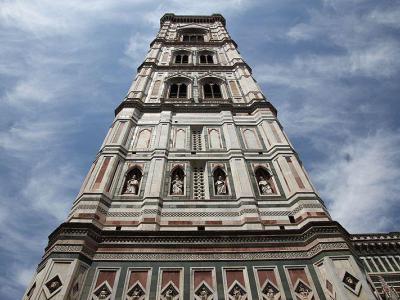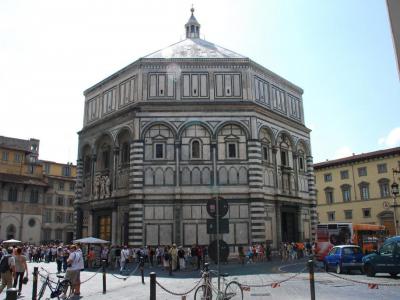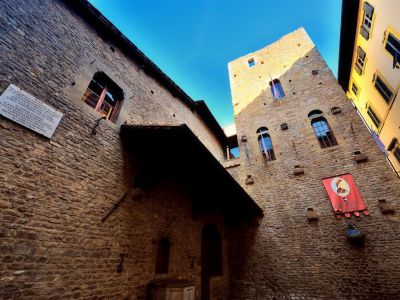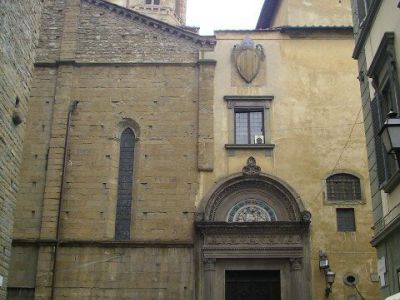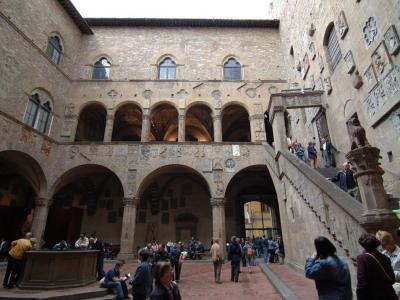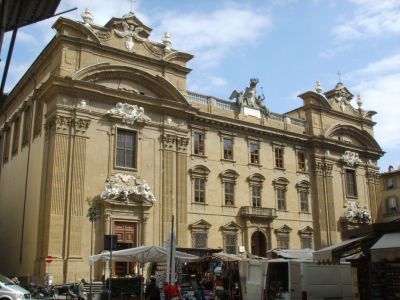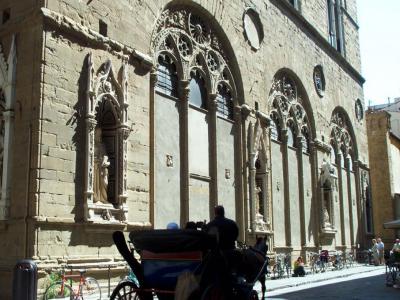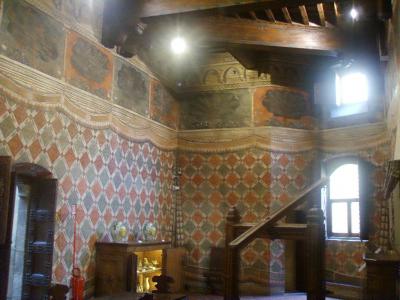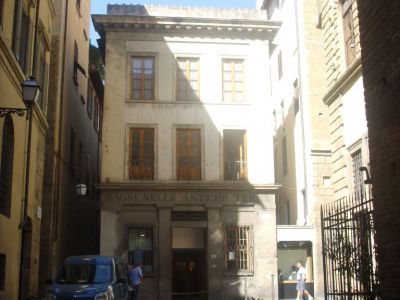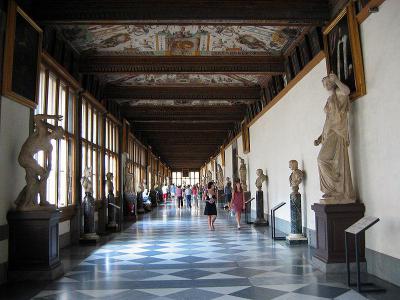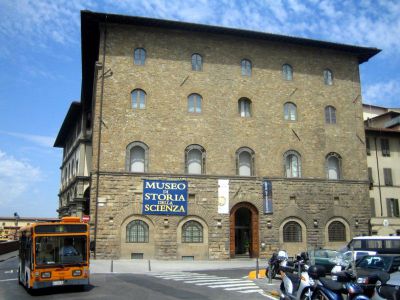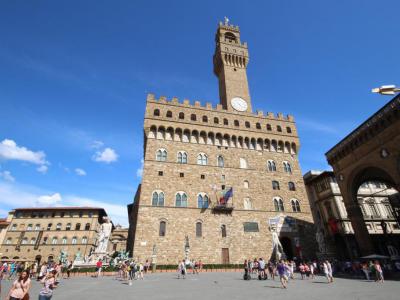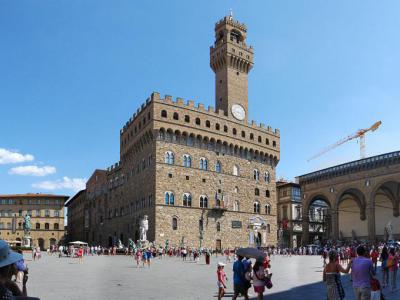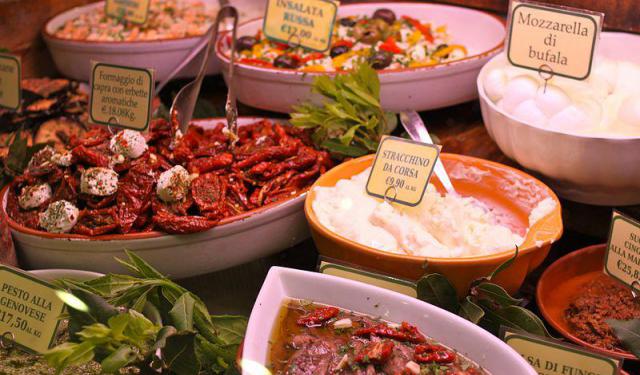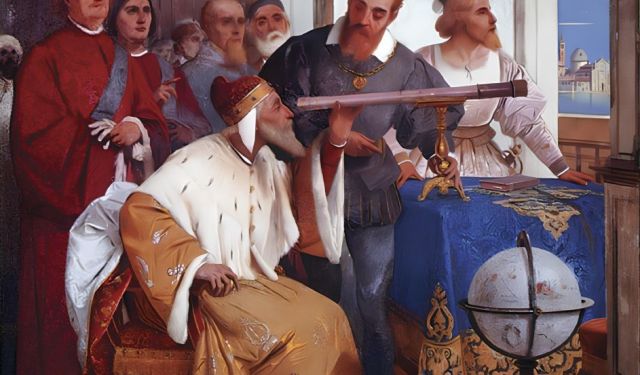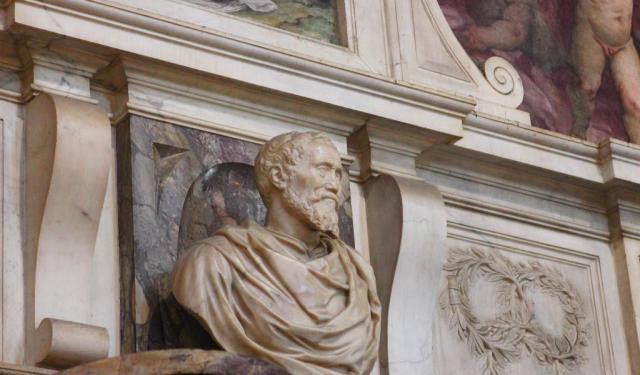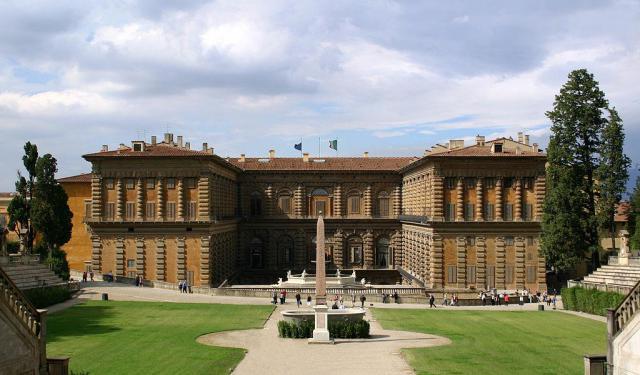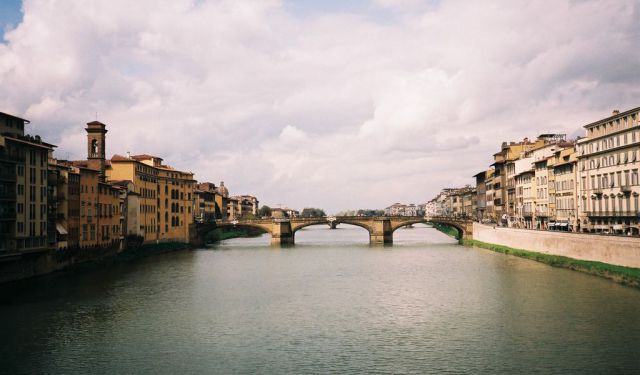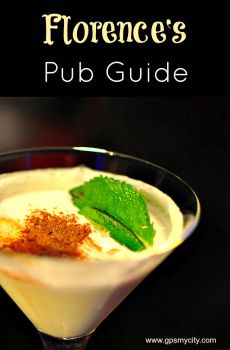Audio Guide: Duomo Walking Tour (Self Guided), Florence
Right in the heart of historic Florence lies the Duomo district-the city's religious and civic core, and one of the most remarkable places in all of Italy. Between the Duomo and Signoria squares, Florence unfolds in layers of art, history, and architectural brilliance, offering a never-ending stream of things to see, do, and admire.
At the center of it all stands the Florence Cathedral, or Duomo, with its iconic red-brick dome that dominates the skyline. Nearby, the elegant 14th-century Bell Tower offers an unforgettable climb and a chance to get up close to the dome itself-plus sweeping views over the city and beyond. Just across the square, the Baptistery of Saint John completes the trio, famous for its golden “Gates of Paradise” and the baptismal font where Dante himself was baptized many centuries ago. These three structures together form part of a UNESCO World Heritage Site.
But the treasures don’t end there. Tucked between the Duomo and Signoria squares, you’ll find Orsanmichele Church, free to enter and full of fascinating detail both inside and out. A short stroll away, the Bargello Museum beckons with its remarkable collection of Renaissance sculpture-including works by Michelangelo, Donatello, and Cellini. And then, of course, there’s the Uffizi Gallery-perhaps Florence’s most famous museum, home to masterpieces by Giotto, Botticelli, and Leonardo da Vinci. Yes, the lines are long-but the art inside is timeless.
Over in Signoria Square stands the Old Palace-once the seat of Cosimo de Medici, now Florence’s City Hall. Just outside, you may admire a stunning collection of open-air sculptures, including a replica of Michelangelo’s “David”, placed exactly where the original once stood.
So if you’re ready to walk through a living museum of art, politics, faith, and architectural marvels, grab your most comfortable shoes and take our self-guided walking tour of the Duomo district. It's history with a view-and you have front-row seats.
At the center of it all stands the Florence Cathedral, or Duomo, with its iconic red-brick dome that dominates the skyline. Nearby, the elegant 14th-century Bell Tower offers an unforgettable climb and a chance to get up close to the dome itself-plus sweeping views over the city and beyond. Just across the square, the Baptistery of Saint John completes the trio, famous for its golden “Gates of Paradise” and the baptismal font where Dante himself was baptized many centuries ago. These three structures together form part of a UNESCO World Heritage Site.
But the treasures don’t end there. Tucked between the Duomo and Signoria squares, you’ll find Orsanmichele Church, free to enter and full of fascinating detail both inside and out. A short stroll away, the Bargello Museum beckons with its remarkable collection of Renaissance sculpture-including works by Michelangelo, Donatello, and Cellini. And then, of course, there’s the Uffizi Gallery-perhaps Florence’s most famous museum, home to masterpieces by Giotto, Botticelli, and Leonardo da Vinci. Yes, the lines are long-but the art inside is timeless.
Over in Signoria Square stands the Old Palace-once the seat of Cosimo de Medici, now Florence’s City Hall. Just outside, you may admire a stunning collection of open-air sculptures, including a replica of Michelangelo’s “David”, placed exactly where the original once stood.
So if you’re ready to walk through a living museum of art, politics, faith, and architectural marvels, grab your most comfortable shoes and take our self-guided walking tour of the Duomo district. It's history with a view-and you have front-row seats.
How it works: Download the app "GPSmyCity: Walks in 1K+ Cities" from Apple App Store or Google Play Store to your mobile phone or tablet. The app turns your mobile device into a personal tour guide and its built-in GPS navigation functions guide you from one tour stop to next. The app works offline, so no data plan is needed when traveling abroad.
Duomo Walking Tour Map
Guide Name: Duomo Walking Tour
Guide Location: Italy » Florence (See other walking tours in Florence)
Guide Type: Self-guided Walking Tour (Sightseeing)
# of Attractions: 14
Tour Duration: 2 Hour(s)
Travel Distance: 2.3 Km or 1.4 Miles
Author: DanaOffice
Sight(s) Featured in This Guide:
Guide Location: Italy » Florence (See other walking tours in Florence)
Guide Type: Self-guided Walking Tour (Sightseeing)
# of Attractions: 14
Tour Duration: 2 Hour(s)
Travel Distance: 2.3 Km or 1.4 Miles
Author: DanaOffice
Sight(s) Featured in This Guide:
- Cattedrale di Santa Maria del Fiore (Florence Cathedral)
- Campanile di Giotto (Giotto's Bell Tower)
- Battistero di San Giovanni (Baptistery of St. John)
- Casa di Dante (Dante House-Museum)
- Badia Fiorentina (Florentine Abbey)
- Palazzo del Bargello (Bargello National Museum)
- Complesso di San Firenze (San Firenze Complex)
- Chiesa e Museo di Orsanmichele (Church and Museum of Orsanmichele)
- Museo di Palazzo Davanzati (Museum of the Old Florentine House)
- Piazza del Limbo (Limbo Square)
- Galleria degli Uffizi (Uffizi Gallery)
- Museo Galileo (Galileo Museum)
- Palazzo Vecchio (Old Palace)
- Piazza della Signoria (Signoria Square)
1) Cattedrale di Santa Maria del Fiore (Florence Cathedral) (must see)
Towering over the city of Florence, the Florence Cathedral is a true Renaissance masterpiece-best known for its massive masonry dome, the largest of its kind in the world. Completed in 1465, this remarkable double-shell structure is entirely self-supporting and remains one of the greatest engineering marvels of its time.
The cathedral’s story begins in 1296, when construction of its Gothic design first got underway. The real breakthrough, however, came nearly 150 years later, when architect Filippo Brunelleschi stepped in to solve what many thought was an impossible challenge-building the dome. Inspired by the ancient Pantheon in Rome, Brunelleschi ran countless experiments using large-scale models and even invented custom machinery to get the job done.
Among his most remarkable inventions were lifting devices and pulley systems capable of raising over 37,000 tons of materials-including more than four million bricks. His work impressed a young apprentice named Leonardo da Vinci, who sketched the machines-drawings that were later mistakenly credited to him. But history has remembered the true innovator. Today, Brunelleschi’s statue stands in the piazza outside the Cathedral as a tribute to his genius.
Step inside, and you’ll find more treasures-like the fresco “Dante and the Divine Comedy” by Domenico di Michelino, painted in 1465. It shows the poet holding his famous book, surrounded by vivid imagery of Hell, Purgatory, and Heaven, along with a detailed view of Florence as it looked in the 15th century-ironically, a version of the city Dante himself never saw. To see it up close, be prepared to climb about 450 steps up a narrow staircase that spirals inside the dome.
And then there's the exterior-a stunning patchwork of colorful marbles so intricate it almost looks painted. The craftsmanship is nothing short of extraordinary.
Tip: When booking online, you’ll get free access to the top of the dome-but you’ll need to reserve a time slot separately. The reward is a 360-degree view of Florence, the Tuscan countryside, and the mountains beyond. Totally worth the climb.
The cathedral’s story begins in 1296, when construction of its Gothic design first got underway. The real breakthrough, however, came nearly 150 years later, when architect Filippo Brunelleschi stepped in to solve what many thought was an impossible challenge-building the dome. Inspired by the ancient Pantheon in Rome, Brunelleschi ran countless experiments using large-scale models and even invented custom machinery to get the job done.
Among his most remarkable inventions were lifting devices and pulley systems capable of raising over 37,000 tons of materials-including more than four million bricks. His work impressed a young apprentice named Leonardo da Vinci, who sketched the machines-drawings that were later mistakenly credited to him. But history has remembered the true innovator. Today, Brunelleschi’s statue stands in the piazza outside the Cathedral as a tribute to his genius.
Step inside, and you’ll find more treasures-like the fresco “Dante and the Divine Comedy” by Domenico di Michelino, painted in 1465. It shows the poet holding his famous book, surrounded by vivid imagery of Hell, Purgatory, and Heaven, along with a detailed view of Florence as it looked in the 15th century-ironically, a version of the city Dante himself never saw. To see it up close, be prepared to climb about 450 steps up a narrow staircase that spirals inside the dome.
And then there's the exterior-a stunning patchwork of colorful marbles so intricate it almost looks painted. The craftsmanship is nothing short of extraordinary.
Tip: When booking online, you’ll get free access to the top of the dome-but you’ll need to reserve a time slot separately. The reward is a 360-degree view of Florence, the Tuscan countryside, and the mountains beyond. Totally worth the climb.
2) Campanile di Giotto (Giotto's Bell Tower) (must see)
The famous Bell Tower of Giotto is one of Florence’s most iconic landmarks. Though it stands beside the Cathedral, it’s actually a freestanding belfry, designed by the legendary artist and architect Giotto di Bondone-the very same Giotto who’s often credited as the first great figure of the Italian Renaissance. Rising to a height of 85 meters, this stunning structure is a remarkable example of Florentine Gothic architecture, adorned with sculptural details and colorful marble inlays in white, green, and red.
Sadly, Giotto passed away before the tower was completed, and two other architects had to carry on the work. Still, his artistic touch is unmistakable-from the marble patterns on the façade to the figurative cycle within the belfry. He may not have finished it, but his vision set the tone for everything that followed.
Yes, you can climb the tower-and of the three major ones in Florence, this one is actually the easiest to scale. The staircase has 414 steps, but they’re well spaced, with rest areas between levels. Each stop reveals one of the seven bells inside-one for each note on the musical scale. Unlike the often-crowded Cathedral, this famous landmark feels more open, with room to pause, catch your breath, and enjoy the views.
And those views are something else. From the top, you’ll get a rare angle on the Cathedral’s dome, a neat view of the Baptistery, and a sweeping look across the city’s red-tiled rooftops and winding streets-many of which have barely changed in centuries.
Tip: Your combo ticket for the Florence Cathedral complex includes access to the Bell Tower-no reservation needed. Once activated, the ticket is valid for 72 hours, giving you plenty of time to visit the other sites. While you may have to wait in line, the queue for the tower is usually short and moves quickly.
Sadly, Giotto passed away before the tower was completed, and two other architects had to carry on the work. Still, his artistic touch is unmistakable-from the marble patterns on the façade to the figurative cycle within the belfry. He may not have finished it, but his vision set the tone for everything that followed.
Yes, you can climb the tower-and of the three major ones in Florence, this one is actually the easiest to scale. The staircase has 414 steps, but they’re well spaced, with rest areas between levels. Each stop reveals one of the seven bells inside-one for each note on the musical scale. Unlike the often-crowded Cathedral, this famous landmark feels more open, with room to pause, catch your breath, and enjoy the views.
And those views are something else. From the top, you’ll get a rare angle on the Cathedral’s dome, a neat view of the Baptistery, and a sweeping look across the city’s red-tiled rooftops and winding streets-many of which have barely changed in centuries.
Tip: Your combo ticket for the Florence Cathedral complex includes access to the Bell Tower-no reservation needed. Once activated, the ticket is valid for 72 hours, giving you plenty of time to visit the other sites. While you may have to wait in line, the queue for the tower is usually short and moves quickly.
3) Battistero di San Giovanni (Baptistery of St. John)
The beautiful Florence Baptistery, dedicated to Saint John the Baptist-patron saint of the city-stands prominently on Cathedral Square, opposite the Duomo. Raised in the 7th century over an ancient Roman structure thought to be a temple honoring Mars, the building features a distinctive octagonal shape. Early Christians frequently chose this eight-sided design for baptisteries, symbolizing renewal-the six days of creation, one day of rest, and the day of rebirth through baptism.
During its renovation in 1059, artisans covered the baptistery in alternating bands of white and dark green marble, giving the exterior its striking striped appearance. Yet, the baptistery is perhaps most famous for the three remarkable sets of bronze doors. The south doors depict moments from Saint John's life, combined with beautiful representations of the eight Christian virtues. The north doors, crafted by Lorenzo Ghiberti over 21 long years, illustrate scenes from the life of Christ. Ghiberti later devoted another 27 years to the spectacular east doors, famously described by Michelangelo as the “Gates of Paradise.” This extraordinary artwork features ten elaborate panels portraying the story of Joseph.
Inside, visitors can gaze upward at magnificent mosaics decorating the ceiling and view the baptismal font, in use since 1576. Francesco de’ Medici, Florence’s powerful ruler, had his son baptized here-just one among numerous notable figures who have shared this honor, including generations of the influential Medici family. Indeed, nearly every Catholic Florentine, up until the 19th century, received baptism within these very walls, making the Baptistery a core component of the city's religious heritage.
Florence's beloved poet Dante references this cherished building in his masterpiece, the “Divine Comedy.” Born in May 1265, the poet was originally named Durante, meaning “enduring,” after his maternal grandfather-though eventually, his family shortened the name to Dante.
Tip: Your standard ticket for the Duomo attractions includes access to the Baptistery, valid for 72 hours. Note that there's a strict dress code: shoulders and knees must be covered for both men and women, so please dress appropriately. To attend the daily mass, arrive around 10:30 AM at the door opposite the main entrance and mention “mass” or “messa” to the attendant.
During its renovation in 1059, artisans covered the baptistery in alternating bands of white and dark green marble, giving the exterior its striking striped appearance. Yet, the baptistery is perhaps most famous for the three remarkable sets of bronze doors. The south doors depict moments from Saint John's life, combined with beautiful representations of the eight Christian virtues. The north doors, crafted by Lorenzo Ghiberti over 21 long years, illustrate scenes from the life of Christ. Ghiberti later devoted another 27 years to the spectacular east doors, famously described by Michelangelo as the “Gates of Paradise.” This extraordinary artwork features ten elaborate panels portraying the story of Joseph.
Inside, visitors can gaze upward at magnificent mosaics decorating the ceiling and view the baptismal font, in use since 1576. Francesco de’ Medici, Florence’s powerful ruler, had his son baptized here-just one among numerous notable figures who have shared this honor, including generations of the influential Medici family. Indeed, nearly every Catholic Florentine, up until the 19th century, received baptism within these very walls, making the Baptistery a core component of the city's religious heritage.
Florence's beloved poet Dante references this cherished building in his masterpiece, the “Divine Comedy.” Born in May 1265, the poet was originally named Durante, meaning “enduring,” after his maternal grandfather-though eventually, his family shortened the name to Dante.
Tip: Your standard ticket for the Duomo attractions includes access to the Baptistery, valid for 72 hours. Note that there's a strict dress code: shoulders and knees must be covered for both men and women, so please dress appropriately. To attend the daily mass, arrive around 10:30 AM at the door opposite the main entrance and mention “mass” or “messa” to the attendant.
4) Casa di Dante (Dante House-Museum)
Florence underwent dramatic changes during the Renaissance, but in the city’s eastern quarter, you can still feel the spirit of the Middle Ages. Winding your way through its narrow alleys and tucked-away corners, you’ll find yourself stepping into scenes that Florence’s most famous poet, Dante Alighieri, would recognize even today. Not far from the parish church where he first laid eyes on Beatrice Portinari, his lifelong muse, stands Casa di Dante, the house believed to be his childhood home.
Now a three-story museum, the space offers a thoughtful look at the life and legacy of the man behind the “Divine Comedy”. On the ground floor, you’ll explore his early years in Florence. The second level focuses on the turning point of his life-the exile-and the time he spent in Ravenna, where he eventually died. Climb to the top floor, and you’ll find a collection of the poet’s personal items, along with replicas carefully recreated to reflect his world. One standout piece is a miniature edition of the “Divina Comedia”-the smallest printed version of the famous text, and a testament to its enduring legacy.
Dante’s epic poem takes the reader on a journey through the afterlife-guided first by the Roman poet Virgil through Hell and Purgatory, then by Beatrice through the realms of Paradise. Though Dante himself called the work simply "The Comedy," it gained popularity over the centuries, and in 1555, a lavish edition published in Venice gave us the name we know today.
Tip: The museum’s staircase is quite steep, but there is an elevator-just note that it’s a bit tucked away and might not be obvious when you first walk in. Keep an eye out, especially if you're hoping to skip the stairs.
Now a three-story museum, the space offers a thoughtful look at the life and legacy of the man behind the “Divine Comedy”. On the ground floor, you’ll explore his early years in Florence. The second level focuses on the turning point of his life-the exile-and the time he spent in Ravenna, where he eventually died. Climb to the top floor, and you’ll find a collection of the poet’s personal items, along with replicas carefully recreated to reflect his world. One standout piece is a miniature edition of the “Divina Comedia”-the smallest printed version of the famous text, and a testament to its enduring legacy.
Dante’s epic poem takes the reader on a journey through the afterlife-guided first by the Roman poet Virgil through Hell and Purgatory, then by Beatrice through the realms of Paradise. Though Dante himself called the work simply "The Comedy," it gained popularity over the centuries, and in 1555, a lavish edition published in Venice gave us the name we know today.
Tip: The museum’s staircase is quite steep, but there is an elevator-just note that it’s a bit tucked away and might not be obvious when you first walk in. Keep an eye out, especially if you're hoping to skip the stairs.
5) Badia Fiorentina (Florentine Abbey)
One of the oldest churches in Florence, this historic abbey dates all the way back to 978, founded by Willa, the widow of Count Uberto of Tuscany. It became the burial place of their son, Count Ugo, whose tomb still stands today as a tribute to the family’s legacy. Inside, visitors can also admire a powerful work of art: Filippino Lippi’s “Apparition of the Virgin to Saint Bernard”, painted in 1485. This Renaissance marvel adds a burst of emotion and life to the otherwise quiet interior and remains one of the city’s most admired paintings.
The abbey originally followed the Benedictine rule and held an important place in the spiritual and cultural life of medieval Florence. Over time, it went through several changes, especially during a major renovation in the 17th century that gave the building much of its Baroque character. Still, traces of its Romanesque and Gothic roots are easy to spot for those who know where to look.
If you’re visiting, try to make time for the “Cloister of the Orange Trees.” Although the real-life trees planted by monks are long gone, the space remains peaceful and visually striking, with early frescoes lining the walls and a view of the 14th-century hexagonal bell tower, mentioned by Dante in the “Paradiso” section of “The Divine Comedy”. The cloister is only open on Monday afternoons, and can be tricky to find-look for a small door to the right of the altar.
It is also said that Dante likely studied at this very abbey during his youth. Some even believe he first laid eyes on Beatrice, his lifelong muse, in the nearby church.
Today, this sacred place is cared for by the Fraternity of Jerusalem, a contemplative community whose members chant the Divine Office each evening around 6 PM. The experience is quietly moving, drawing tourists and locals alike.
The abbey originally followed the Benedictine rule and held an important place in the spiritual and cultural life of medieval Florence. Over time, it went through several changes, especially during a major renovation in the 17th century that gave the building much of its Baroque character. Still, traces of its Romanesque and Gothic roots are easy to spot for those who know where to look.
If you’re visiting, try to make time for the “Cloister of the Orange Trees.” Although the real-life trees planted by monks are long gone, the space remains peaceful and visually striking, with early frescoes lining the walls and a view of the 14th-century hexagonal bell tower, mentioned by Dante in the “Paradiso” section of “The Divine Comedy”. The cloister is only open on Monday afternoons, and can be tricky to find-look for a small door to the right of the altar.
It is also said that Dante likely studied at this very abbey during his youth. Some even believe he first laid eyes on Beatrice, his lifelong muse, in the nearby church.
Today, this sacred place is cared for by the Fraternity of Jerusalem, a contemplative community whose members chant the Divine Office each evening around 6 PM. The experience is quietly moving, drawing tourists and locals alike.
6) Palazzo del Bargello (Bargello National Museum) (must see)
Florence is a haven for architecture enthusiasts and art lovers, and the Bargello Museum elevates this experience even further. Set within the walls of a medieval fortress, the museum houses some of Italy’s most prized sculptures and artworks.
Also known as the People’s Palace, the Bargello dates back to 1255, making it one of Florence’s oldest surviving structures. Over the centuries, it’s served many roles-starting in the 16th century, when it housed Florence’s chief of police, also called the “bargello.” Later, it functioned as a prison before finally being transformed into a museum in the mid-19th century. Since then, it’s become the ultimate destination for Gothic and Renaissance sculpture.
Inside, you’ll encounter masterpieces by iconic artists like Michelangelo, Donatello, Verrocchio, and Brunelleschi, to name just a few. One of the museum’s most celebrated pieces is Donatello’s “David”, a landmark work that became the first male nude sculpture publicly displayed since ancient times-marking a turning point in European art. Michelangelo’s contributions include “Bacchus”, “Pitti Tondo” (also known as “Madonna and Child”), “Brutus”, and “David-Apollo”. “Bacchus”, which Michelangelo carved at just 22 years old, is particularly striking. The figure’s rolling eyes and teetering posture give it an almost lifelike instability, reflecting a daringly androgynous quality that marked a bold step in the artist’s early career.
Beyond the Renaissance sculptures, the museum offers treasures from the Byzantine, Roman, and Medieval periods. You’ll also find exquisite jewelry-some pieces from the European Renaissance, others with Islamic origins. English descriptions accompany all exhibits, making the experience both accessible and informative.
Tip: Check the museum’s website ahead of time for opening hours. On certain days, the Bargello stays open late, giving visitors the chance to explore the medieval setting in a peaceful, near-empty atmosphere. It’s an unforgettable way to experience these works of art.
Also known as the People’s Palace, the Bargello dates back to 1255, making it one of Florence’s oldest surviving structures. Over the centuries, it’s served many roles-starting in the 16th century, when it housed Florence’s chief of police, also called the “bargello.” Later, it functioned as a prison before finally being transformed into a museum in the mid-19th century. Since then, it’s become the ultimate destination for Gothic and Renaissance sculpture.
Inside, you’ll encounter masterpieces by iconic artists like Michelangelo, Donatello, Verrocchio, and Brunelleschi, to name just a few. One of the museum’s most celebrated pieces is Donatello’s “David”, a landmark work that became the first male nude sculpture publicly displayed since ancient times-marking a turning point in European art. Michelangelo’s contributions include “Bacchus”, “Pitti Tondo” (also known as “Madonna and Child”), “Brutus”, and “David-Apollo”. “Bacchus”, which Michelangelo carved at just 22 years old, is particularly striking. The figure’s rolling eyes and teetering posture give it an almost lifelike instability, reflecting a daringly androgynous quality that marked a bold step in the artist’s early career.
Beyond the Renaissance sculptures, the museum offers treasures from the Byzantine, Roman, and Medieval periods. You’ll also find exquisite jewelry-some pieces from the European Renaissance, others with Islamic origins. English descriptions accompany all exhibits, making the experience both accessible and informative.
Tip: Check the museum’s website ahead of time for opening hours. On certain days, the Bargello stays open late, giving visitors the chance to explore the medieval setting in a peaceful, near-empty atmosphere. It’s an unforgettable way to experience these works of art.
7) Complesso di San Firenze (San Firenze Complex)
At the edge of San Firenze Square, just a short stroll from the Uffizi Gallery, stands one of Florence’s most distinctive Baroque landmarks-a 17th-century architectural ensemble that has served a variety of purposes over the centuries. During Italy’s “Risorgimento”, or national unification movement, the site played a key role by hosting major political gatherings. Nowadays, it blends religious, civic, and cultural functions, all under one historic roof, and remains a shining example of Florentine Baroque.
Among the complex’s highlights is the Oratory, now a venue for concerts and cultural events. Historically, it was used for religious instruction and community outreach by the Oratorians, a congregation known for their emphasis on education and service. Nearby, you’ll find the Church of Saint Philip Neri, still fulfilling its role as a place of worship. Step inside to admire rich stucco decorations, gilded altars, striking frescoes on the ceiling, and a beautifully ornate organ-all hallmarks of the dramatic Baroque style.
Another standout feature is the Franco Zeffirelli Foundation (open Tuesday through Sunday, 10 AM to 6 PM). Named after the acclaimed Florentine-born director, the foundation honors a career that spanned over seven decades. Zeffirelli is best known for his 1968 film “Romeo and Juliet”, which earned him an Academy Award nomination, as well as “Tea with Mussolini” and high-profile collaborations with stars like Elizabeth Taylor and Richard Burton. His impressive body of work includes 18 films, 31 theatrical productions, and over 100 operas-all chronicled in a dedicated museum.
Visitors can unwind in the tearoom on the ground floor, which opens into a peaceful courtyard. Next door, a shop sells books and memorabilia related to Zeffirelli’s life and career-a perfect stop for film lovers looking to connect more deeply with his legacy.
Among the complex’s highlights is the Oratory, now a venue for concerts and cultural events. Historically, it was used for religious instruction and community outreach by the Oratorians, a congregation known for their emphasis on education and service. Nearby, you’ll find the Church of Saint Philip Neri, still fulfilling its role as a place of worship. Step inside to admire rich stucco decorations, gilded altars, striking frescoes on the ceiling, and a beautifully ornate organ-all hallmarks of the dramatic Baroque style.
Another standout feature is the Franco Zeffirelli Foundation (open Tuesday through Sunday, 10 AM to 6 PM). Named after the acclaimed Florentine-born director, the foundation honors a career that spanned over seven decades. Zeffirelli is best known for his 1968 film “Romeo and Juliet”, which earned him an Academy Award nomination, as well as “Tea with Mussolini” and high-profile collaborations with stars like Elizabeth Taylor and Richard Burton. His impressive body of work includes 18 films, 31 theatrical productions, and over 100 operas-all chronicled in a dedicated museum.
Visitors can unwind in the tearoom on the ground floor, which opens into a peaceful courtyard. Next door, a shop sells books and memorabilia related to Zeffirelli’s life and career-a perfect stop for film lovers looking to connect more deeply with his legacy.
8) Chiesa e Museo di Orsanmichele (Church and Museum of Orsanmichele)
Once a modest 8th-century oratory, this structure has gone through quite a few changes over the centuries. By 1290, it had been repurposed into an open-air loggia where locals came to buy and sell grain. After a fire swept through just a decade later, the building was rebuilt as a covered loggia-market. Then in the late 14th century, its open arches were replaced with windows. Although those openings are now bricked up, you can still make out the elegant Gothic tracery that hints at the structure’s medieval past.
Inside, the space is divided into two parallel naves, creating a layout that feels both intimate and grand. On the right side stands a remarkable 14th-century Gothic altar-a work of true artistry, featuring cherubs, carved reliefs, and richly colored marble and glass. At its center is Bernardo Daddi’s “Virgin and Child”, framed by delicately sculpted angels that seem to watch over the room.
Walk around the outside, and you’ll see a series of niches along the outer walls-each one housing a statue of a patron saint representing Florence’s powerful trade guilds. Among the fourteen figures featured are Saint Mark, Saint Philip, Saint Thomas, Saint James, Saint Peter, John the Baptist, and Madonna of the Rose, each reflecting the pride and spiritual devotion of their respective guild.
One sculpture that truly stands out is “Doubting Thomas”, created around 1470. In a brilliant touch, the figure of Christ remains fully contained within the niche, while Saint Thomas steps forward-his right foot breaking the frame. That small gesture, subtle as it is, gives a surprising sense of movement and realism to the entire piece. To see the original sculptures, visitors can stop by the adjacent museum, which is open on Mondays.
Inside, the space is divided into two parallel naves, creating a layout that feels both intimate and grand. On the right side stands a remarkable 14th-century Gothic altar-a work of true artistry, featuring cherubs, carved reliefs, and richly colored marble and glass. At its center is Bernardo Daddi’s “Virgin and Child”, framed by delicately sculpted angels that seem to watch over the room.
Walk around the outside, and you’ll see a series of niches along the outer walls-each one housing a statue of a patron saint representing Florence’s powerful trade guilds. Among the fourteen figures featured are Saint Mark, Saint Philip, Saint Thomas, Saint James, Saint Peter, John the Baptist, and Madonna of the Rose, each reflecting the pride and spiritual devotion of their respective guild.
One sculpture that truly stands out is “Doubting Thomas”, created around 1470. In a brilliant touch, the figure of Christ remains fully contained within the niche, while Saint Thomas steps forward-his right foot breaking the frame. That small gesture, subtle as it is, gives a surprising sense of movement and realism to the entire piece. To see the original sculptures, visitors can stop by the adjacent museum, which is open on Mondays.
9) Museo di Palazzo Davanzati (Museum of the Old Florentine House)
Tucked away in the heart of Florence, this 14th-century palace was originally built as the residence of the Davizzi clan of merchants and bankers. In 1578, it changed hands to the Davanzati, a family closely tied to the Papal court in Avignon. They left their mark by adding a grand coat of arms to the façade, which still catches the eye. Now known as the Museum of the Old Florentine House, the building offers a rare and immersive glimpse into how wealthy Florentine families lived from the Medieval through Renaissance periods-complete with frescoes, sculptures, paintings, and period furnishings.
To fully appreciate the place, guided visits to the upper floors are highly recommended. These can be reserved in advance online or arranged directly with the receptionist upon arrival. Upstairs, you’ll explore the private quarters where the family once lived, including a beautifully recreated 15th-century bedrooms, with frescoed walls and a striking marital bed. The kitchen is another highlight, stocked with authentic tools and cookware from the era-a true time capsule.
On the lower floors, visitors can explore independently. Here you'll find delicate collections of lace and embroidery, as well as the famous Parrot Room, named for its whimsical bird and floral frescoes-a favorite for photographers and art lovers alike.
The museum was first opened to the public in the early 20th century by Elia Volpi, an antique dealer who restored the palace and curated its furnishings. Thanks to his vision, the space has retained a truly atmospheric charm.
To fully appreciate the place, guided visits to the upper floors are highly recommended. These can be reserved in advance online or arranged directly with the receptionist upon arrival. Upstairs, you’ll explore the private quarters where the family once lived, including a beautifully recreated 15th-century bedrooms, with frescoed walls and a striking marital bed. The kitchen is another highlight, stocked with authentic tools and cookware from the era-a true time capsule.
On the lower floors, visitors can explore independently. Here you'll find delicate collections of lace and embroidery, as well as the famous Parrot Room, named for its whimsical bird and floral frescoes-a favorite for photographers and art lovers alike.
The museum was first opened to the public in the early 20th century by Elia Volpi, an antique dealer who restored the palace and curated its furnishings. Thanks to his vision, the space has retained a truly atmospheric charm.
10) Piazza del Limbo (Limbo Square)
This ancient square, famously mentioned in Dante’s “Divine Comedy”, once sat just beyond the Roman walls of ancient Florence. It wasn’t until the construction of new Carolingian fortifications in the 10th century that the area became part of the city proper. Its current name comes from a somber medieval tradition-the burial ground for unbaptized infants, believed at the time to be destined for Limbo in the afterlife.
Looking onto the square is the Church of the Holy Apostles, one of Florence’s oldest surviving churches, with much of its early medieval character still intact. Two plaques on the front recall its legendary origins. One, written in Latin, claims that Charlemagne, along with paladins Roland, Oliviero, and Bishop Turpin, founded the church on April 6, 801.
Nearby, the Borgherini-Rosselli del Turco Palace comes into view. Its shorter side faces the square and displays several fascinating plaques and carvings: a monogram of Christ, a bas-relief of the Madonna and Child, and two inscriptions etched in Pietra Serena stone, each with devotional messages. In earlier times, the Borgherini family maintained a rare private garden here-something almost unheard of in densely built medieval Florence. Ownership eventually passed to the Rosselli del Turco family, whose name the building still carries.
To the right of the church stands the former Altoviti family palace, its façade marked by a bold stone coat of arms. Also in the area are remnants of 19th-century public baths, built on the very spot where Florentia’s original Roman baths once stood-a quiet reminder of the city's layered past.
Altogether, this quiet corner of Florence carries layer upon layer of history-Roman, medieval, and Renaissance-woven into its stones and facades, waiting for curious visitors to take notice.
Looking onto the square is the Church of the Holy Apostles, one of Florence’s oldest surviving churches, with much of its early medieval character still intact. Two plaques on the front recall its legendary origins. One, written in Latin, claims that Charlemagne, along with paladins Roland, Oliviero, and Bishop Turpin, founded the church on April 6, 801.
Nearby, the Borgherini-Rosselli del Turco Palace comes into view. Its shorter side faces the square and displays several fascinating plaques and carvings: a monogram of Christ, a bas-relief of the Madonna and Child, and two inscriptions etched in Pietra Serena stone, each with devotional messages. In earlier times, the Borgherini family maintained a rare private garden here-something almost unheard of in densely built medieval Florence. Ownership eventually passed to the Rosselli del Turco family, whose name the building still carries.
To the right of the church stands the former Altoviti family palace, its façade marked by a bold stone coat of arms. Also in the area are remnants of 19th-century public baths, built on the very spot where Florentia’s original Roman baths once stood-a quiet reminder of the city's layered past.
Altogether, this quiet corner of Florence carries layer upon layer of history-Roman, medieval, and Renaissance-woven into its stones and facades, waiting for curious visitors to take notice.
11) Galleria degli Uffizi (Uffizi Gallery) (must see)
If you could only visit one Renaissance landmark in Florence-or even the entire world-the Uffizi Gallery would be the top contender. Originally designed as government offices for the magistrates of Florence, this grand building was commissioned in the 16th century by Cosimo de’ Medici and brought to life by Giorgio Vasari. Though built for administrative purposes, the palace quickly evolved into the perfect setting for the Medici family’s extraordinary art collection. By 1765, the gallery opened its doors to the public and has since become one of Florence’s most visited museums.
Here, you’ll come face-to-face with some of the most iconic works in art history. Highlights include Sandro Botticelli’s “Birth of Venus” and “Adoration of the Magi”, as well as masterpieces by Leonardo da Vinci, Michelangelo, and Caravaggio. One of Michelangelo’s works displayed is “Doni Tondo”-a circular painting nearly four feet across that depicts the Holy Family. Created in 1504, it gives us an early glimpse of the vibrant palette the artist would later use in his frescoes on the Sistine Chapel ceiling.
While paintings and sculptures are the main attraction, don’t overlook the gallery’s interior design. The ceilings are intricately decorated, and each room carries its own sense of grandeur. With more than 50 opulent rooms to wander through, it’s easy to feel overwhelmed. That’s why a break at the rooftop café is a smart move. Grab a coffee, rest your feet, and soak in the stunning views of Florence that you won’t find anywhere else.
Because of its global fame, the Uffizi is rarely quiet. Expect long lines, especially during high season. Booking your ticket in advance through the official website is highly recommended-it will save you time, and you might even catch a discount. And one last note before you go: no liquids are allowed inside, so plan accordingly.
Here, you’ll come face-to-face with some of the most iconic works in art history. Highlights include Sandro Botticelli’s “Birth of Venus” and “Adoration of the Magi”, as well as masterpieces by Leonardo da Vinci, Michelangelo, and Caravaggio. One of Michelangelo’s works displayed is “Doni Tondo”-a circular painting nearly four feet across that depicts the Holy Family. Created in 1504, it gives us an early glimpse of the vibrant palette the artist would later use in his frescoes on the Sistine Chapel ceiling.
While paintings and sculptures are the main attraction, don’t overlook the gallery’s interior design. The ceilings are intricately decorated, and each room carries its own sense of grandeur. With more than 50 opulent rooms to wander through, it’s easy to feel overwhelmed. That’s why a break at the rooftop café is a smart move. Grab a coffee, rest your feet, and soak in the stunning views of Florence that you won’t find anywhere else.
Because of its global fame, the Uffizi is rarely quiet. Expect long lines, especially during high season. Booking your ticket in advance through the official website is highly recommended-it will save you time, and you might even catch a discount. And one last note before you go: no liquids are allowed inside, so plan accordingly.
12) Museo Galileo (Galileo Museum)
A visit to this museum is a deep dive into the legacy of Galileo Galilei, the brilliant scientist born in Pisa in 1564, remembered for his groundbreaking work in astronomy, physics, and motion. Inside, you’ll discover a captivating collection of scientific instruments, including Galileo’s original telescopes and the very lens he used to observe the moons of Jupiter, changing our understanding of the universe forever. Large-scale reconstructions of his experiments-on motion, gravity, and acceleration-can also be found throughout the galleries, and from time to time, staff members offer live demonstrations that bring these ideas vividly to life.
In 1657, Florence honored Galileo by founding the Academy for Experimentation, the world’s first scientific institute of its kind. Several of the academy’s earliest innovations are also on display here, including some of the first thermometers, hygrometers, and barometers ever made.
Among other highlights, keep an eye out for the 1554 world map by Portuguese cartographer Lopo Homem, an intricately detailed piece of Renaissance geography. There’s also a fascinating array of nautical tools designed by Sir Robert Dudley, an English marine engineer who worked unde the Medici dukes to help develop the port of Livorno.
Those drawn to English literature will uncover unexpected connections, while fans of design and craftsmanship will appreciate the artistic beauty found in these early scientific devices. For engineers and inventors, the museum is a playground of historical innovation. And while it leans more toward observation than interaction, students and and curious minds of all ages will find plenty to engage with.
If you're visiting during Florence’s warmer months, here’s a modern-day bonus: your ticket includes access to one of the city’s rarest luxuries-air-conditioning.
In 1657, Florence honored Galileo by founding the Academy for Experimentation, the world’s first scientific institute of its kind. Several of the academy’s earliest innovations are also on display here, including some of the first thermometers, hygrometers, and barometers ever made.
Among other highlights, keep an eye out for the 1554 world map by Portuguese cartographer Lopo Homem, an intricately detailed piece of Renaissance geography. There’s also a fascinating array of nautical tools designed by Sir Robert Dudley, an English marine engineer who worked unde the Medici dukes to help develop the port of Livorno.
Those drawn to English literature will uncover unexpected connections, while fans of design and craftsmanship will appreciate the artistic beauty found in these early scientific devices. For engineers and inventors, the museum is a playground of historical innovation. And while it leans more toward observation than interaction, students and and curious minds of all ages will find plenty to engage with.
If you're visiting during Florence’s warmer months, here’s a modern-day bonus: your ticket includes access to one of the city’s rarest luxuries-air-conditioning.
13) Palazzo Vecchio (Old Palace) (must see)
Just like the Cathedral complex and Florence’s world-class galleries, the Old Palace is essential for anyone wanting to grasp the city's history and cultural identity. This massive Romanesque fortress is one of the most striking town halls in all of Tuscany. Since 1872, it has served as the office of Florence’s mayor, but its legacy stretches much further back. Built in 1299, the edifice was the political heart of the Florentine Republic for centuries. When Cosimo de’ Medici moved in with his family in 1540 as Grand Duke, he had it expanded and transformed, blending its medieval bones with elegant Renaissance flair.
The rugged stone façade, lined with shields chronicling Florence’s political past, is also home to an impressive lineup of statues. These include Florence’s heraldic symbol- the Marzocco lion, along with Donatello’s powerful “Judith and Holofernes”, and “Hercules and Cacus”. The nearby Tower of Arnolfo, rising above the palace, offers a climbable vantage point-though access requires a separate ticket.
Meanwhile, inside, every room tells a chapter of the city’s history. You’ll walk through the spectacular Hall of the Five Hundred, designed to glorify Medici rule, and into the more private quarters where the family lived. Decorated under the artistic direction of Giorgio Vasari, these spaces are rich in symbolism and political narrative. Give yourself time to move slowly through the rooms-it’s an immersive dive into Florentine grandeur. And be warned: you may leave with a crick in your neck from gazing.
One standout work here is Michelangelo’s “Genius of Victory”. Originally meant for the tomb of Pope Julius II, the sculpture depicts a young, triumphant figure standing over a defeated older man. The contrast between the two is striking-the victor is smooth and polished, the vanquished figure unfinished and rough, still bearing the weight of the stone.
You’ll also come across something rather haunting-a death mask of Dante Alighieri, displayed between the Apartments of Eleanor and the Halls of the Priors. Though the poet was buried in Ravenna, this plaster cast has become a powerful reminder of his influence on Florence, both politically and culturally. Fans of Dan Brown’s “Inferno” will surely recognize it from the novel.
Tip: If you’re planning a guided visit, it’s best to book directly with the museum by email-include your preferred date and time, and wait for confirmation. Payment is made on the day of your tour, and afterward, you’re free to continue exploring on your own. Just keep in mind: because this is still a working municipal building, access may occasionally be restricted. It’s a good idea to check the official website before you go.
The rugged stone façade, lined with shields chronicling Florence’s political past, is also home to an impressive lineup of statues. These include Florence’s heraldic symbol- the Marzocco lion, along with Donatello’s powerful “Judith and Holofernes”, and “Hercules and Cacus”. The nearby Tower of Arnolfo, rising above the palace, offers a climbable vantage point-though access requires a separate ticket.
Meanwhile, inside, every room tells a chapter of the city’s history. You’ll walk through the spectacular Hall of the Five Hundred, designed to glorify Medici rule, and into the more private quarters where the family lived. Decorated under the artistic direction of Giorgio Vasari, these spaces are rich in symbolism and political narrative. Give yourself time to move slowly through the rooms-it’s an immersive dive into Florentine grandeur. And be warned: you may leave with a crick in your neck from gazing.
One standout work here is Michelangelo’s “Genius of Victory”. Originally meant for the tomb of Pope Julius II, the sculpture depicts a young, triumphant figure standing over a defeated older man. The contrast between the two is striking-the victor is smooth and polished, the vanquished figure unfinished and rough, still bearing the weight of the stone.
You’ll also come across something rather haunting-a death mask of Dante Alighieri, displayed between the Apartments of Eleanor and the Halls of the Priors. Though the poet was buried in Ravenna, this plaster cast has become a powerful reminder of his influence on Florence, both politically and culturally. Fans of Dan Brown’s “Inferno” will surely recognize it from the novel.
Tip: If you’re planning a guided visit, it’s best to book directly with the museum by email-include your preferred date and time, and wait for confirmation. Payment is made on the day of your tour, and afterward, you’re free to continue exploring on your own. Just keep in mind: because this is still a working municipal building, access may occasionally be restricted. It’s a good idea to check the official website before you go.
14) Piazza della Signoria (Signoria Square) (must see)
Alongside the Cathedral Square-the religious heart of Florence-you’ll find Signoria Square, the city’s historic civic center and a living museum under the open sky. Framed by elegant buildings and top-tier museums, this spot holds a special place in the hearts of locals. It was here that the Florentine Republic took shape, and to this day, the area remains a cherished gathering place. Michelangelo’s original “David” once stood proudly in the square, and while that statue now resides in a museum, a faithful replica now stands in its place, keeping the legacy alive.
Long before the Renaissance, back in Roman times, this was the town center of Florentia, surrounded by a theater, public baths, and a textile workshop. Centuries later, a church, a loggia, and a vast 5th-century basilica rose here, traces of which came to light during excavations in the 1980s.
What makes the square truly captivating is its irregular shape and the wealth of artwork-both monumental and subtle-that surrounds you. It’s a dream for photographers, with striking visuals from every angle. But even without a camera, just standing at the center and slowly turning to take it all in is a moment worth savoring.
Presiding over everything is the medieval Old Palace, still the seat of city government. Nearby, you’ll find the Lanterns’ Lodge-an open-air sculpture gallery that’s free to enter and always open. Here you’ll see dramatic masterpieces like “The Rape of the Sabine Women”, “Hercules and the Centaur”, and “Perseus with the Head of Medusa”, which seems locked in a timeless stare with Michelangelo’s “David”.
There are a few shaded benches for a break, but if you're visiting in summer, take it slow and stay hydrated. The crowds can be thick, so when crossing the square, don’t aim straight-zigzag gently, like a sailboat tacking through the wind. A few graceful steps to the right, a few to the left, and before you know it, you’re there. Simple, smooth, and very Florentine.
Long before the Renaissance, back in Roman times, this was the town center of Florentia, surrounded by a theater, public baths, and a textile workshop. Centuries later, a church, a loggia, and a vast 5th-century basilica rose here, traces of which came to light during excavations in the 1980s.
What makes the square truly captivating is its irregular shape and the wealth of artwork-both monumental and subtle-that surrounds you. It’s a dream for photographers, with striking visuals from every angle. But even without a camera, just standing at the center and slowly turning to take it all in is a moment worth savoring.
Presiding over everything is the medieval Old Palace, still the seat of city government. Nearby, you’ll find the Lanterns’ Lodge-an open-air sculpture gallery that’s free to enter and always open. Here you’ll see dramatic masterpieces like “The Rape of the Sabine Women”, “Hercules and the Centaur”, and “Perseus with the Head of Medusa”, which seems locked in a timeless stare with Michelangelo’s “David”.
There are a few shaded benches for a break, but if you're visiting in summer, take it slow and stay hydrated. The crowds can be thick, so when crossing the square, don’t aim straight-zigzag gently, like a sailboat tacking through the wind. A few graceful steps to the right, a few to the left, and before you know it, you’re there. Simple, smooth, and very Florentine.
Walking Tours in Florence, Italy
Create Your Own Walk in Florence
Creating your own self-guided walk in Florence is easy and fun. Choose the city attractions that you want to see and a walk route map will be created just for you. You can even set your hotel as the start point of the walk.
Florence Food Tour
Food is one of the great Florentine passions, and the great thing about having a delicious authentic Tuscan meal, a snack, delicatessen, or a quality gelato here – besides the abundant variety – is not having to spend a lot of money for it.
In general, the “osterias” and the eateries nestled in Sant’Ambrogio Market will offer cheaper and more casual food with an emphasis on home... view more
Tour Duration: 2 Hour(s)
Travel Distance: 2.6 Km or 1.6 Miles
In general, the “osterias” and the eateries nestled in Sant’Ambrogio Market will offer cheaper and more casual food with an emphasis on home... view more
Tour Duration: 2 Hour(s)
Travel Distance: 2.6 Km or 1.6 Miles
In Galileo's Footsteps
Galileo Galilei-born in Pisa in 1564-spent much of his life in and around Florence, where some of the most defining moments of his revolutionary career unfolded. A genius of many talents-physicist, mathematician, astronomer, inventor-he helped usher in the scientific revolution and reshape humanity’s understanding of the universe. Florence, the cradle of the Renaissance, became a backdrop for... view more
Tour Duration: 3 Hour(s)
Travel Distance: 8.0 Km or 5 Miles
Tour Duration: 3 Hour(s)
Travel Distance: 8.0 Km or 5 Miles
Michelangelo's Masterpieces Walking Tour
Though born in the small Tuscan town of Caprese, Michelangelo spent over two decades of his life in Florence-the heart of the Renaissance. It was here that he grew up, was educated, and began shaping his artistic voice, eventually creating some of the most iconic masterpieces the city has ever known.
His larger-than-life work-“David”-didn’t just reshape the image of biblical heroism-it... view more
Tour Duration: 2 Hour(s)
Travel Distance: 4.0 Km or 2.5 Miles
His larger-than-life work-“David”-didn’t just reshape the image of biblical heroism-it... view more
Tour Duration: 2 Hour(s)
Travel Distance: 4.0 Km or 2.5 Miles
Medici Landmarks Walking Tour
The Medici family helped to establish Florence as the single most important art capital of Renaissance Europe. In order to prove wealth and power, they built numerous palaces, libraries, churches, chapels and personal residences. The Medicis were big lovers of art and they acquired huge, expensive collections, as well as supporting many sculptors and painters of the time.
Designed by... view more
Tour Duration: 1 Hour(s)
Travel Distance: 2.7 Km or 1.7 Miles
Designed by... view more
Tour Duration: 1 Hour(s)
Travel Distance: 2.7 Km or 1.7 Miles
Arno South Bank Walking Tour
The area south of the Arno River-known as Oltrarno, or “Beyond the Arno”-offers a quieter, more intimate side of Florence, but one that’s no less captivating. It’s here that you’ll find the grand Pitti Palace, home to a painting collection rivaled only by the Uffizi Gallery, and the expansive Boboli Gardens, once the private domain of the Medici and later, the royal family. As one of the... view more
Tour Duration: 2 Hour(s)
Travel Distance: 2.4 Km or 1.5 Miles
Tour Duration: 2 Hour(s)
Travel Distance: 2.4 Km or 1.5 Miles
Dante's Florence Walking Tour
Dante Alighieri was arguably the greatest – albeit also most controversial – of Italy's poets. After having served as one of the six priors governing Florence, his political activities – including the banishing of several rivals – led to his own banishment, upon which he wrote his masterpiece, “The Divine Comedy”, as a wanderer, seeking protection for his family in one town after... view more
Tour Duration: 1 Hour(s)
Travel Distance: 2.1 Km or 1.3 Miles
Tour Duration: 1 Hour(s)
Travel Distance: 2.1 Km or 1.3 Miles
Useful Travel Guides for Planning Your Trip
Florence's Tasty Coffee Shop Guide
The caffe scene throughout Italy is an important factor of everyday life. People will pop in to their favorite bar on their way to work for a quick espresso breakfast with a pastry, they’ll grab a slice of pizza for lunch or drop by for an aperitivo before dining out and take a peaceful digestivo...
Souvenir Shopping Guide: 15 Unique Products to Buy in Florence
Compared to other Italian "grands" like Rome, Venice, or Milan, Florence is relatively less-known to an outsider for any local products, save, perhaps, Florentine mosaics and Fiorentina FC. Fortunately, there are tonnes of locally-originated things that this Italian city is rightfully...
Top 13 Pubs in Florence
Florence, the city of art and beauty has no problem in mastering the art of the nightlife as well. Local pubs are very popular and appreciated among the Florentines and the tourists. Locals and native English speakers that study or live in the city cannot wait to welcome tourists in their cozy...
The Most Popular Cities
/ view all
